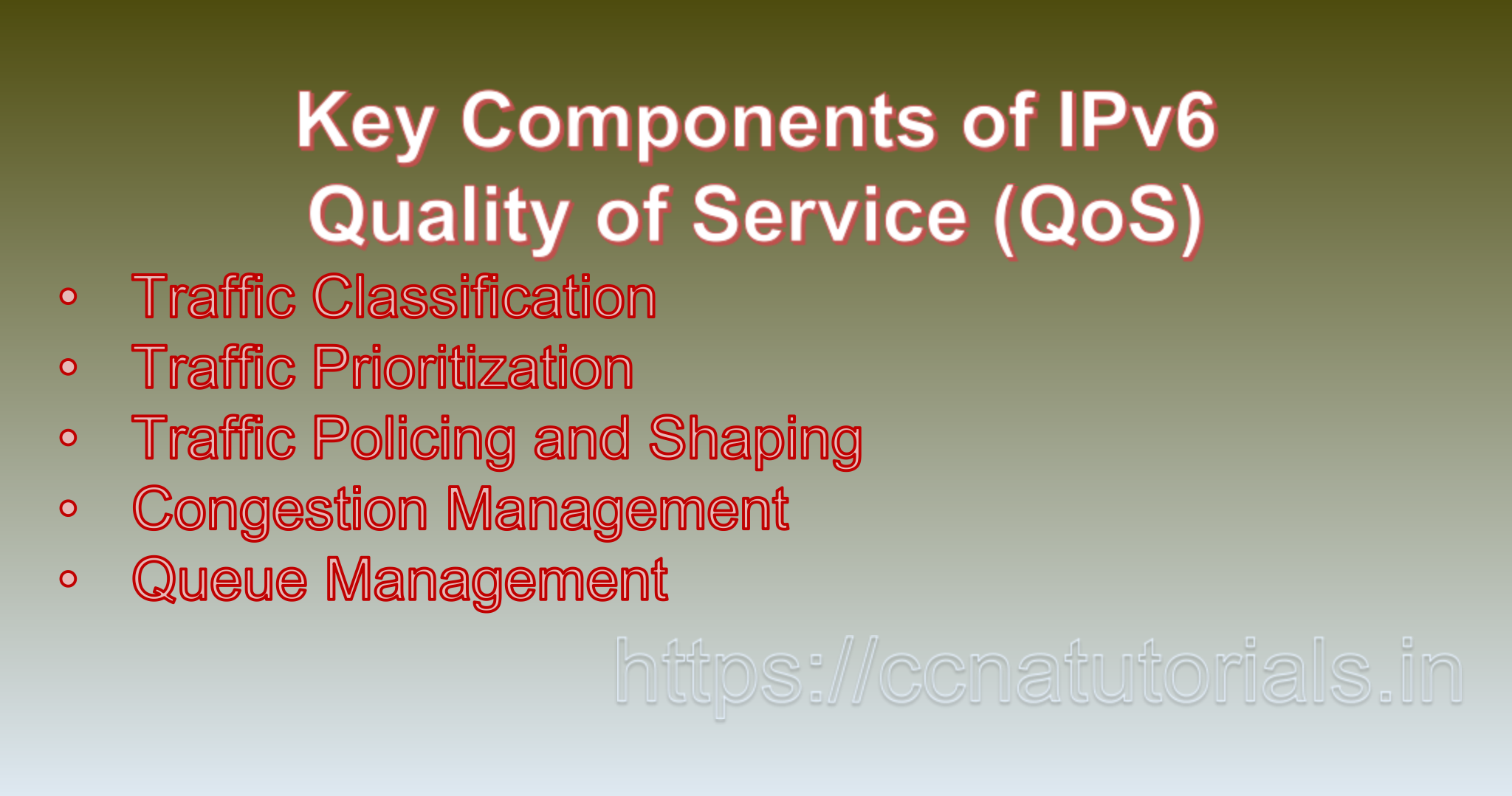Contents of this article
In this article, I describe IPv6 Quality of Service (QoS): Optimizing Network Performance and User Experience IPv6 Quality of Service (QoS) is a set of techniques and mechanisms designed to prioritize and manage network traffic, ensuring that critical applications receive the necessary bandwidth and ensuring a consistent user experience. As the Internet becomes increasingly diverse and traffic-intensive, IPv6 QoS becomes essential for maintaining optimal network performance. This article offers a comprehensive overview of IPv6 QoS, its components, benefits, and a real-world example to illustrate its importance.
Key Components of IPv6 Quality of Service (QoS):
1. Traffic Classification:
QoS begins with identifying different types of network traffic, such as voice, video, data, or real-time applications. This classification allows administrators to apply appropriate policies.
2. Traffic Prioritization:
Once classified, traffic is assigned priority levels based on its importance. Critical traffic, like real-time video conferencing, might be assigned a higher priority than non-time-sensitive data.
3. Traffic Policing and Shaping:
Traffic policing limits the rate of incoming or outgoing traffic to a predefined level, preventing network congestion. Traffic shaping smooths traffic flows by buffering and controlling the rate at which data is sent.
4. Congestion Management:
In case of network congestion, QoS mechanisms ensure fair distribution of available bandwidth among different traffic types, preventing any single application from monopolizing resources.
5. Queue Management:
Routers maintain queues to manage traffic during periods of congestion. QoS algorithms determine how to prioritize traffic in these queues, ensuring that high-priority packets are transmitted promptly.
Benefits of IPv6 Quality of Service (QoS):
1. Enhanced User Experience:
QoS ensures that critical applications, like video conferencing and voice calls, receive sufficient bandwidth to maintain high-quality performance.
2. Optimized Resource Utilization:
By managing traffic flows, QoS prevents unnecessary network congestion, ensuring efficient use of available bandwidth.
3. Predictable Performance:
QoS mechanisms create consistent network behavior, preventing sudden slowdowns or performance degradation during periods of high traffic.
4. Support for Diverse Applications:
IPv6 QoS caters to the varying requirements of different applications, providing a suitable environment for real-time communication, data transfer, and multimedia streaming.
IPv6 Quality of Service (QoS) Example:
Consider a business environment where employees rely heavily on video conferencing for meetings. At the same time, data transfer and email traffic are also crucial. Without proper QoS, these applications might compete for available bandwidth, leading to poor video quality during critical meetings.
Solution:
1. Traffic Classification:
The network administrator classifies traffic into three categories: high-priority (video conferencing), medium-priority (data transfer), and low-priority (email).
2. Traffic Prioritization:
Video conferencing is assigned the highest priority, ensuring that it receives sufficient bandwidth even during periods of congestion. Data transfer is assigned medium priority, and email traffic is assigned low priority.
3. Traffic Policing and Shaping:
Traffic policing is set up to ensure that the video conferencing traffic doesn’t exceed a certain rate. Traffic shaping is used to smooth out data transfer traffic, preventing sudden bursts that could cause congestion.
4. Congestion Management:
During congestion, the QoS mechanisms ensure that video conferencing traffic is transmitted without delay, maintaining its quality. Data transfer and email traffic might experience slight delays, but the impact on critical applications is minimized.
5. Queue Management:
The router maintains queues for each priority level. High-priority video conferencing packets are given immediate attention, followed by medium-priority data transfer, and low-priority email.
In short IPv6 Quality of Service (QoS):
IPv6 Quality of Service (QoS) plays a pivotal role in ensuring consistent, reliable, and efficient network performance, even in the face of diverse and demanding traffic. By prioritizing and managing traffic flows, QoS mechanisms optimize resource utilization, enhance user experiences, and support a wide range of applications. The example scenario demonstrates how QoS can be implemented to prioritize video conferencing over data transfer and email traffic, ensuring a smooth and high-quality communication experience. As networks continue to evolve, IPv6 QoS remains an indispensable tool for maintaining network excellence and user satisfaction.

IPv6 Quality of Service (QoS) is a set of techniques and mechanisms that allow network administrators to manage and control the quality and performance of network traffic. QoS ensures that critical applications receive the necessary bandwidth, latency, and priority, while non-critical traffic is appropriately managed to prevent congestion and ensure a consistent user experience. In the context of IPv6, QoS mechanisms play a crucial role in optimizing network resources and providing a reliable network environment. This article provides an overview of IPv6 QoS, its importance, implementation, and a real-world example.
Importance of IPv6 QoS:
1. Traffic Prioritization:
QoS allows administrators to prioritize certain types of traffic over others, ensuring that essential applications and services receive the necessary resources.
2. Preventing Congestion:
By managing traffic and allocating resources effectively, QoS helps prevent network congestion, which can degrade performance for all users.
3. Latency Management:
QoS mechanisms can be used to control latency, ensuring that delay-sensitive applications such as VoIP and video conferencing maintain acceptable performance.
4. Bandwidth Allocation:
QoS enables the allocation of specific amounts of bandwidth to critical applications, guaranteeing that they have the resources they need.
5. Resource Efficiency:
With proper QoS implementation, network resources are utilized more efficiently, leading to a better user experience and improved productivity.
IPv6 QoS Mechanisms:
1. Traffic Classification:
The first step in QoS is identifying different types of traffic. This is done through techniques like Deep Packet Inspection (DPI), where traffic is examined to determine its nature.
2. Traffic Marking:
Once traffic is classified, it’s marked with appropriate QoS markings, such as Differentiated Services Code Point (DSCP) values. These markings indicate the level of priority or treatment the traffic should receive.
3. Traffic Shaping:
Traffic shaping involves controlling the rate at which packets are sent to prevent network congestion. This is particularly useful for preventing sudden bursts of traffic from overwhelming the network.
4. Traffic Policing:
Traffic policing enforces traffic limits, dropping packets that exceed specified thresholds. This prevents excessive traffic from affecting the quality of service for other users.
5. Queue Management:
QoS mechanisms also manage packet queues, ensuring that packets are transmitted in an orderly and prioritized manner. Different queues can be used for different levels of priority.
Example Scenario:
Imagine a company that heavily relies on VoIP communication for its daily operations. To ensure high call quality and minimal latency, the company decides to implement IPv6 QoS.
1. Traffic Classification:
The company identifies VoIP traffic by inspecting packet headers and identifying the specific protocols and port numbers used by VoIP applications.
2. Traffic Marking:
VoIP traffic is marked with a high-priority DSCP value, indicating that it should be treated with high priority throughout the network.
3. Traffic Shaping:
To prevent sudden bursts of VoIP traffic from overwhelming the network, the company implements traffic shaping. This ensures a steady and controlled flow of VoIP packets.
4. Queue Management:
The company configures network switches to create separate queues for different types of traffic. VoIP traffic is placed in a high-priority queue to ensure low latency and minimal delay.
5. Traffic Policing:
Traffic policing is implemented to limit the amount of VoIP traffic that can enter the network. This prevents excessive VoIP traffic from consuming all available bandwidth.
With these IPv6 QoS mechanisms in place, the company can ensure that its VoIP calls receive the necessary bandwidth, low latency, and high priority, even during periods of heavy network usage. This leads to reliable communication and a positive user experience.
Conclusion for IPv6 Quality of Service (QoS):
IPv6 Quality of Service (QoS) is a crucial element of modern networking that allows organizations to manage and optimize network traffic for performance, reliability, and resource efficiency. By prioritizing critical traffic, preventing congestion, and controlling latency, QoS mechanisms enhance the user experience for both essential and non-essential applications. The example scenario illustrates how an organization can implement IPv6 QoS to ensure high-quality VoIP communication, even in the presence of other network traffic. As networks continue to evolve, IPv6 QoS remains a vital tool for maintaining optimal network performance and meeting the demands of diverse applications and services. You may contact us for any query related to this article.






